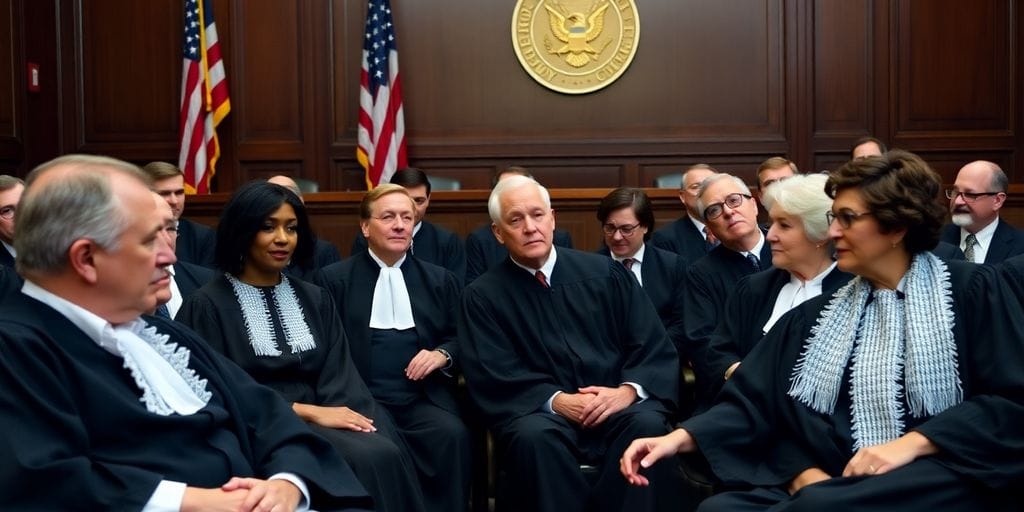Explore the roles of Solicitor vs Lawyer in the UK and U.S. legal systems, comparing their responsibilities, court appearances, and client interactions.
The legal systems in the UK and the US have common roots, but they have developed distinct characteristics over time. Understanding the differences between barristers, solicitors, and lawyers can help individuals navigate their legal options more effectively. This article highlights the key distinctions that set these legal professionals apart in their respective systems.
Key Takeaways
- In the US, the term ‘lawyer’ refers to all legal professionals, while in the UK, there are specific roles: solicitors and barristers.
- Solicitors handle most legal work outside of court, whereas barristers are courtroom specialists who represent clients in trials.
- Training paths differ significantly; solicitors often work in firms, while barristers usually operate from chambers after completing specific advocacy training.
- Billing practices vary; solicitors typically charge by the hour, while barristers may have daily rates or fixed fees for cases.
- The regulatory bodies for these professionals differ, with solicitors governed by the Solicitors Regulation Authority (SRA) and barristers overseen by the Bar Standards Board (BSB).
Historical Roots and Evolution of Legal Systems

Origins of the UK Legal System
The UK legal system has its roots in the early medieval period, particularly influenced by the establishment of the king’s court, known as the curia regis. This court was pivotal in shaping the legal landscape, as it laid the groundwork for the common law system that would evolve over centuries. The legal principles developed during this time were based on customs and judicial decisions rather than written statutes.
Development of the US Legal System
The US legal system emerged from the British legal tradition, particularly after the American Revolution. The founding fathers were influenced by English common law, but they sought to create a system that reflected the values of a new nation. This led to the establishment of a federal system, where both state and federal laws coexist, allowing for a diverse legal framework across the country.
Common Law Influences
Both the UK and US legal systems share a foundation in common law, which emphasizes the role of judicial decisions in shaping legal principles. This system allows for flexibility and adaptability, as judges interpret laws based on precedents. The following table summarizes key influences on both systems:
| Aspect | UK Legal System | US Legal System |
|---|---|---|
| Historical Roots | Curia Regis, medieval customs | British common law, post-Revolution |
| Legal Framework | Common law, statutes | Federal and state laws |
| Judicial Role | Precedent-based decisions | Precedent and constitutional law |
The evolution of legal systems reflects the changing needs and values of society, adapting to new challenges while maintaining core principles.
This historical context is essential for understanding the differences and similarities between the legal professions in the UK and the US, particularly in how solicitors, barristers, and lawyers operate within their respective systems.
Terminology and Definitions
Understanding ‘Lawyer’ in the US
In the United States, the term lawyer is a broad label that encompasses all legal professionals. This includes those who represent clients in court as well as those who provide legal advice without appearing in court. Essentially, every lawyer is a legal practitioner, but not all lawyers are trial lawyers.
Defining ‘Solicitor’ and ‘Barrister’ in the UK
In the UK, the legal profession is divided into two main categories: solicitors and barristers. Solicitors typically handle legal matters outside of court, such as:
- Providing legal advice
- Drafting documents
- Managing contracts
Barristers, on the other hand, are specialized courtroom advocates. They are often called upon by solicitors to represent clients in more complex legal matters, particularly in trials. Barristers are trial lawyers, while solicitors manage the preparatory work.
Comparative Analysis of Legal Terms
The differences in terminology between the US and UK legal systems can be summarized in the following table:
| Term | US Definition | UK Definition |
|---|---|---|
| Lawyer | General term for legal professionals | Can refer to both solicitors and barristers |
| Solicitor | Not commonly used; all lawyers are considered lawyers | Handles legal matters outside of court |
| Barrister | Not a distinct role; all lawyers can represent clients | Specializes in courtroom representation |
In summary, understanding these terms is crucial for navigating the legal systems in both countries.
The distinction between solicitors and barristers is essential for anyone seeking legal help in the UK. Knowing who to approach can significantly impact the outcome of a case.
Overall, the terminology reflects the different roles and responsibilities that legal professionals hold in each system, highlighting the unique characteristics of the UK and US legal frameworks.
Roles and Responsibilities of Legal Professionals
Solicitors: Duties and Functions
Solicitors play a crucial role in the legal system, acting as the first point of contact for clients. Their responsibilities include:
- Providing legal advice to clients on various matters.
- Handling all paperwork and communication related to cases.
- Representing clients in court when necessary, although they often work with barristers for complex cases.
In essence, solicitors are specialists in their fields, often focusing on specific areas of law, such as family or corporate law. They ensure that clients are well-informed and supported throughout the legal process.
Barristers: Courtroom Specialists
Barristers are primarily known for their courtroom advocacy. Their key duties include:
- Interpreting the law and providing legal opinions.
- Preparing cases for court, including drafting legal arguments.
- Representing clients in court, presenting their cases to judges and juries.
Barristers often specialize in specific areas of law, which allows them to provide expert advice and representation. They are typically hired by solicitors to handle cases that require courtroom appearances.
Lawyers in the US: A Unified Role
In the United States, the term “lawyer” encompasses both solicitors and barristers. Lawyers have a more unified role, which includes:
- Advising clients on legal matters.
- Representing clients in court.
- Handling all aspects of a case from start to finish.
This means that a lawyer in the US can perform the functions of both a solicitor and a barrister, providing a more streamlined service to clients.
In summary, while solicitors and barristers have distinct roles in the UK legal system, lawyers in the US operate under a more unified framework, allowing them to serve clients comprehensively. Understanding these differences is essential for navigating legal systems effectively.
Training and Qualifications
Educational Pathways for Solicitors
To become a solicitor in England and Wales, you must follow a specific path:
- Obtain a qualifying law degree (like an LLB) or a non-law degree followed by a conversion course (e.g., PGDL).
- Pass the Solicitors Qualifying Exam (SQE), which consists of two parts: SQE1 and SQE2.
- Complete two years of Qualifying Work Experience (QWE), which can be gained at any point during your training.
| Step | Description |
|---|---|
| 1 | Qualifying law degree or conversion course |
| 2 | Pass SQE1 and SQE2 exams |
| 3 | Complete two years of QWE |
Becoming a Barrister: Required Training
To qualify as a barrister, you need to:
- Complete a qualifying law degree or a non-law degree followed by a conversion course.
- Finish the Bar Professional Training Course (BPTC).
- Secure a pupillage in a barristers’ chambers for practical experience.
Barristers must also be called to the Bar by one of the four Inns of Court after completing their training.
US Legal Education and Bar Admission
In the United States, the path to becoming a lawyer generally includes:
- Earning a bachelor’s degree in any field.
- Completing a Juris Doctor (JD) degree from an accredited law school.
- Passing the bar exam in the state where you wish to practice.
The training and qualifications for legal professionals vary significantly between the UK and the US, reflecting the distinct legal traditions and systems in each country.
In summary, while both systems require rigorous education and training, the specific steps and qualifications differ, highlighting the unique characteristics of each legal profession.
Courtroom Practices and Procedures
UK Courtroom Dynamics
In the UK, courtroom practices are steeped in tradition. Judges and barristers wear wigs and robes, which symbolize respect for the legal system. The Crown Court handles serious criminal cases, while magistrate courts deal with minor offenses. Unlike in the US, UK courts do not typically allow cameras, although this is slowly changing.
US Courtroom Practices
In contrast, US courtrooms are often televised, allowing the public to witness trials. Judges and lawyers wear distinctive robes, but not wigs. The US legal system has a more informal atmosphere, with juries being pre-selected by both sides. This process differs significantly from the random selection in the UK.
Role of Solicitors and Barristers in Court
In the UK, solicitors prepare cases and may represent clients in lower courts, while barristers specialize in courtroom advocacy. In the US, lawyers perform both roles, handling everything from preparation to representation.
| Aspect | UK Legal System | US Legal System |
|---|---|---|
| Courtroom Attire | Wigs and robes | Distinctive robes |
| Camera Presence | Limited, mostly not allowed | Commonly allowed |
| Jury Selection | Random selection | Pre-selected |
The courtroom environment reflects the historical roots of each legal system, influencing how justice is perceived and delivered.
Overall, while both systems aim to deliver justice, their practices and procedures highlight their unique legal traditions and cultural values.
Fee Structures and Billing Practices
Solicitors’ Billing Methods
Solicitors typically use a billable hour model, where clients are charged based on the time spent on their case. This can include:
- Hourly rates: Clients pay for each hour worked.
- Fixed fees: A set amount for specific services, like drafting a will.
- Contingency fees: Payment is only made if the case is won, often seen in personal injury cases.
Barristers’ Fee Arrangements
Barristers often have different billing practices compared to solicitors. They usually charge:
- Daily rates: A flat fee for each day of work.
- Retainers: An upfront fee before starting work, followed by daily charges.
- Success fees: Additional fees based on the outcome of the case, particularly in no-win, no-fee agreements.
US Lawyers’ Billing Practices
In the United States, lawyers have a more unified approach to billing, which can include:
- Hourly billing: Similar to solicitors, charging by the hour.
- Flat fees: A fixed price for specific legal services.
- Retainer agreements: Clients pay a set fee to retain services over a period.
| Profession | Common Billing Method | Typical Fee Structure |
|---|---|---|
| Solicitors | Billable hour | Hourly, fixed, contingency |
| Barristers | Daily rate | Retainer, success fees |
| US Lawyers | Hourly or flat fee | Retainer agreements |
Understanding the hidden costs of bad legal counsel is crucial. Poor legal advice can lead to prolonged litigation, financial strain, and emotional distress.
In summary, while solicitors and barristers in the UK have distinct billing practices, US lawyers often adopt a more integrated approach. Each system has its own advantages and challenges, making it essential for clients to understand these differences when seeking legal assistance.
Regulatory Bodies and Professional Standards

Solicitors Regulation Authority (SRA)
The Solicitors Regulation Authority (SRA) oversees solicitors in England and Wales. It ensures that solicitors meet high standards of professional conduct. Key responsibilities include:
- Setting rules for solicitors
- Monitoring compliance with these rules
- Handling complaints against solicitors
Bar Standards Board (BSB)
The Bar Standards Board (BSB) regulates barristers in England and Wales. It focuses on maintaining the integrity of the bar and ensuring barristers provide quality service. Its main functions include:
- Establishing training and qualification standards
- Enforcing professional conduct rules
- Investigating complaints against barristers
Regulation of Lawyers in the US
In the United States, the regulation of lawyers varies by state. Each state has its own bar association that governs the legal profession. Key points include:
- Admission to the bar is state-specific
- Each state sets its own ethical rules
- Complaints against lawyers are handled by state bar associations
| Regulatory Body | Jurisdiction | Key Functions |
|---|---|---|
| SRA | England & Wales | Regulates solicitors, sets rules, handles complaints |
| BSB | England & Wales | Regulates barristers, sets training standards, investigates complaints |
| State Bar | Varies by state | Regulates lawyers, sets ethical rules, handles complaints |
Regulatory bodies play a crucial role in ensuring that legal professionals maintain high standards and serve the public effectively.
Conclusion
Understanding the roles of these regulatory bodies is essential for anyone navigating the legal systems in the UK and the US. They ensure that legal professionals are held accountable and adhere to established standards, ultimately protecting clients and the integrity of the legal profession.
Work Environments and Employment
Solicitors in Law Firms and In-House
Solicitors typically work in law firms or as in-house counsel for companies. Their roles often include:
- Client consultations to understand legal needs.
- Drafting legal documents such as contracts and wills.
- Negotiating settlements on behalf of clients.
In law firms, solicitors may have to meet billable hour targets, which can lead to long working hours, especially in larger firms.
Barristers in Chambers
Barristers usually operate from chambers, which are shared office spaces. Their responsibilities include:
- Representing clients in court.
- Advising solicitors on complex legal matters.
- Specializing in specific areas of law, such as criminal or family law.
Barristers often enjoy more flexibility in their schedules compared to solicitors, as they can choose their cases and working hours.
Employment Patterns of US Lawyers
In the United States, lawyers generally work in a more unified role. They may:
- Practice in law firms or as solo practitioners.
- Engage in various legal tasks, from advising clients to representing them in court.
- Work in diverse fields, including corporate law, criminal law, and public interest law.
The work environment for US lawyers can vary widely, from high-pressure law firms to more relaxed settings in non-profit organizations.
In both the UK and US, the legal profession offers diverse career paths, but the work environments and employment patterns differ significantly. Understanding these differences can help aspiring legal professionals make informed decisions about their careers.
Public Access and Client Interaction
Direct Access to Solicitors
In the UK, solicitors can be contacted directly by the public at any time. This accessibility allows individuals to seek legal advice without needing to go through another professional. Solicitors often build long-term relationships with clients, providing ongoing support and guidance.
Public Access Scheme for Barristers
Barristers, however, have a different approach. They are generally instructed by solicitors, but they can also be accessed directly through the Public Access Scheme. This scheme is available for straightforward cases, but it does not cover work funded by Legal Aid. Additionally, cases involving children typically do not qualify for public access.
Client Interaction in the US
In the United States, the term “lawyer” encompasses both solicitors and barristers, leading to a more unified role. Lawyers in the US often have direct contact with clients from the beginning of a case, allowing for a more integrated approach to legal representation. This can lead to a more personal relationship between the lawyer and the client, as they work closely together throughout the legal process.
Key Differences in Client Interaction
- Solicitors: Direct contact with clients, often maintaining long-term relationships.
- Barristers: Typically instructed by solicitors, with less direct client interaction.
- US Lawyers: Unified role with direct client access, fostering closer relationships.
Understanding the differences in public access and client interaction is crucial for navigating the legal systems in both the UK and the US. The Public Access Scheme highlights the unique role of barristers, while solicitors maintain a more direct relationship with clients.
This distinction is essential for anyone seeking legal assistance, as it shapes how they engage with legal professionals in each system.
Specialization and Areas of Practice
Specializations Among Solicitors
Solicitors often focus on specific areas of law, allowing them to develop expertise in their chosen field. Common specializations include:
- Personal Injury: Handling cases related to accidents and compensation.
- Family Law: Dealing with divorce, child custody, and related issues.
- Employment Law: Addressing workplace disputes and discrimination cases.
Barristers’ Areas of Expertise
Barristers also tend to specialize, often in more niche areas. Their specializations can include:
- Criminal Law: Representing clients in criminal cases.
- Commercial Law: Focusing on business-related legal issues.
- Chancery Law: Involving estates, trusts, and property disputes.
US Lawyers’ Practice Areas
In the United States, the term “lawyer” encompasses both solicitors and barristers, leading to a more unified role. Common practice areas include:
- Criminal Law: Defending or prosecuting criminal cases.
- Family Law: Similar to the UK, focusing on family-related legal matters.
- Corporate Law: Advising businesses on legal obligations and rights.
Both solicitors and barristers can specialize in multiple areas, but many choose to focus on one to enhance their expertise.
| Type of Legal Professional | Common Specializations |
|---|---|
| Solicitor | Personal Injury, Family Law, Employment Law |
| Barrister | Criminal Law, Commercial Law, Chancery Law |
| US Lawyer | Criminal Law, Family Law, Corporate Law |
Understanding these specializations helps clients choose the right legal professional for their needs. The legal profession in England has evolved, leading to a more integrated approach to legal practice, where the roles of solicitors and barristers are increasingly intertwined.
Judicial Hierarchies and Court Systems
UK Judicial Structure
The UK has a unified court system that handles various types of cases. It consists of several tiers:
- Magistrates’ Courts: Handle minor criminal and civil cases.
- Crown Court: Deals with serious criminal cases and appeals from Magistrates’ Courts.
- Court of Appeal: Reviews decisions from lower courts.
- Supreme Court: The highest court, addressing significant legal issues.
US Federal and State Courts
In the US, the judicial system is divided into federal and state courts:
- District Courts: The trial courts for federal cases.
- Circuit Courts: Handle appeals from District Courts.
- State Courts: Each state has its own court system, handling local laws and cases.
- Supreme Court: The highest court in the US, overseeing both federal and state issues.
Tribunal Systems and Appeals
The UK also has a Tribunal System that resolves specific disputes, such as employment or immigration issues. This system allows:
- Initial hearings in specialized tribunals.
- Appeals to the Upper Tribunal.
- Further appeals to the Court of Appeal if necessary.
In contrast, the US does not have a similar tribunal system, relying instead on its court hierarchy for all legal matters.
The judicial systems in both countries share historical roots but have evolved to meet their unique legal needs.
| Court Level | UK | US |
|---|---|---|
| Lowest Level | Magistrates’ Courts | District Courts |
| Intermediate Level | Crown Court | Circuit Courts |
| Highest Level | Supreme Court | Supreme Court |
Conclusion
In summary, the roles of barristers, solicitors, and lawyers differ significantly between the UK and the US. While both legal systems have common roots, they have evolved distinct practices. In the UK, solicitors typically handle legal matters outside of court, while barristers focus on courtroom representation. In contrast, the US uses the term “lawyer” for all legal professionals, without separating them into distinct roles. Understanding these differences is crucial for anyone navigating legal issues in either country, as it can impact the choice of legal representation and the overall legal process.
Frequently Asked Questions
What is the main difference between a solicitor and a barrister?
A solicitor usually works with clients outside of court, giving advice and preparing documents. A barrister, on the other hand, specializes in representing clients in court.
Can solicitors represent clients in court?
Yes, solicitors can represent clients in some cases, but they often refer more complex cases to barristers.
What does the term ‘lawyer’ mean in the US?
In the US, ‘lawyer’ is a general term for anyone who has been trained in law and is licensed to practice.
How do I become a solicitor in the UK?
To become a solicitor in the UK, you need to complete a law degree, followed by a legal practice course, and then secure a training contract.
What training do barristers need?
Barristers must complete a law degree, followed by the Bar course, and then undertake a period of training called pupillage.
Are there different types of lawyers in the US?
Yes, in the US, there are various types of lawyers, including litigators who go to court and non-litigators who handle legal matters outside of court.
How do solicitors charge for their services?
Solicitors typically charge by the hour, but they may also use fixed fees for certain services.
What is a ‘cab-rank’ rule for barristers?
The ‘cab-rank’ rule means that barristers must accept any case they are qualified for, ensuring that everyone has access to legal help.



